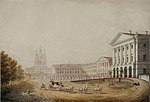Nyenschantz

Nyenschantz (Russian: Ниенша́нц, Nienshants; Swedish: Nyenskans; Finnish: Nevanlinna) was a Swedish fortress at the confluence of the Neva River and Okhta River, the site of present-day Saint Petersburg, Russia. Nyenschantz was built in 1611 to establish Swedish rule in Ingria, which had been annexed from the Tsardom of Russia during the Time of Troubles. The town of Nyen, which formed around Nyenschantz, became a wealthy trading center and a capital of Swedish Ingria during the 17th century. In 1702, Nyenschantz and Nyen were conquered by Russia during the Great Northern War, and the new Russian capital of Saint Petersburg was established by Peter the Great in their place the following year.
Excerpt from the Wikipedia article Nyenschantz (License: CC BY-SA 3.0, Authors, Images).Nyenschantz
Красногвардейская площадь, Saint Petersburg Malaya Okhta (округ Малая Охта)
Geographical coordinates (GPS) Address Nearby Places Show on map
Geographical coordinates (GPS)
| Latitude | Longitude |
|---|---|
| N 59.9441666767 ° | E 30.4069444544 ° |
Address
Охтинский мыс
Красногвардейская площадь
195027 Saint Petersburg, Malaya Okhta (округ Малая Охта)
Saint Petersburg, Russia
Open on Google Maps










